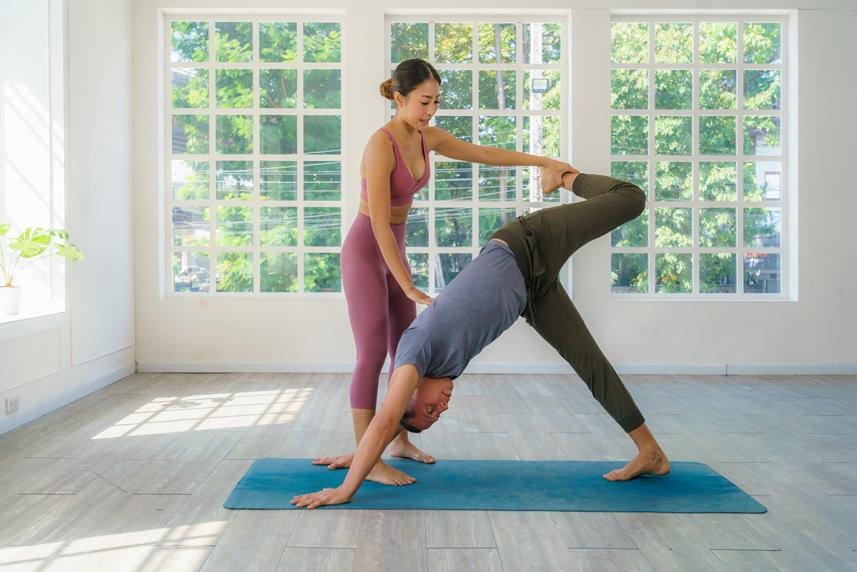
We have you covered — schedule a virtual visit today. No insurance required.

Looking for more calm in your life? Learn why yoga can help cut stress (and boost your health), one deep breath at a time.
If stress is getting to you, give yoga a try. This mind-body practice can reduce stress because it helps you relax. And you’ll benefit from it whether you’re a total beginner or you’ve been taking classes for years.
Bonus: Reducing stress can boost your health in other ways, too. Read on to learn how yoga can soothe your mind and body.
Yoga combines physical poses, controlled breathing and meditation. There are many yoga styles. Hatha yoga is the most popular type taught in the U.S. and is a good option for stress management, according to the Mayo Clinic. Classes involve holding a series of “postures” (poses). These align your body, improve strength and flexibility, and calm your mind. You can find many options for yoga classes online or in-person.
Yoga can help you manage stress in several ways. And there’s science to support it.
Women who did 12 sessions of yoga saw a significant decrease in stress, anxiety and depression, according to a 2018 study. Research shows that levels of the stress hormone cortisol went down after men did 90 minutes of yoga stretching, per a study published in 2020.
Getting a handle on stress is important because chronic stress can harm your health. “Chronic stress is linked to inflammation throughout the body, which can affect every system, including your heart, lungs, brain, gut and joints,” says B Grace Bullock, PhD. She’s a psychologist and yoga educator in Eugene, Oregon.
Over time, that can cause problems such as heart disease, high blood pressure, stroke, digestive problems, sleep woes and weight gain.
To reap the stress-reducing benefits of yoga, it helps to stay focused. “If yoga has become just one more thing you have to do in your already busy day, then it may end up being one more stressor and will likely not help you relieve stress,” says Bullock. Also, you want a class to challenge you but not be so hard that you just give up.
“View your yoga as exploration, and take it one day at a time,” Bullock says. “Think about doing your best to accept where you are and what you can do that day.”
Now you’re in the right mindset. Here’s how yoga can bring the calm.
It evens out your breathing. Every yoga class involves breathwork, something yoga experts call pranayama. Your instructor will prompt you to inhale and exhale during a pose. Or you might be asked to focus on your breath as you lie quietly on the mat.
And that’s a good thing, because studies show that pranayama can decrease stress. “The aim of yogic breathwork is to focus on breathing while clearing your mind and reducing stress,” says Meera Watts, founder of Siddhi Yoga, which offers online yoga classes.
Tip: The exhale is more important than the inhale. “Your exhalation is actually the key to relieving physiological stress,” Bullock says. During focused breathwork, see if you can make your exhales longer than your inhales.
(Find more ideas for mini mindfulness practices here.)
It forces you to focus on the present. During a class, you won’t be able to worry about the fight you had with your sister or your child’s homework project. When you’re standing on 1 leg on your yoga mat, you have to focus on the pose — and just the pose. This will give you a short break from everyday stress.
The physical movement makes you feel better. You already know that doing something active — such as going for a walk — helps fight stress. Yoga does the same thing.
Physical movement increases blood flow throughout your body, which can relax you. Plus yoga, as with nearly every form of exercise, promotes the release of feel-good chemicals in your brain called endorphins.
It’s okay to challenge your body to move in new ways in yoga. But it’s not wise to push well beyond your physical limits. Otherwise, you could injure yourself, Bullock says.

We have you covered — schedule a virtual visit today. No insurance required.
Relaxation poses calm you down. Almost every yoga class ends with a pose called savasana, or corpse pose. “It’s done at the end of class to give your body much-needed relaxation,” Watts says. You lie on your back, close your eyes and clear your mind. After a few minutes, you may feel a sense of calm wash over you.
For savasana to work its magic, schedule your yoga class for a time when you can really relax. Taking a class on your lunch break, for example, might not be optimal if you’re worried about an afternoon meeting. If that’s the case, move your yoga to a different time of day.
And if you don’t have time for a full class, that’s okay. Take a mini break and do a few yoga poses in your living room. It’ll do your mind and body good.
Are your muscles sore from your workout? Check out our selection of percussive massage guns at the Optum Store.
Additional sources
Stress study: International Journal of Preventive Medicine (2018). “The Effect of Yoga on Stress, Anxiety, and Depression in Women”
Stretching study: Journal of Sports Science & Medicine (2020): “Beneficial Effects of Yoga Stretching on Salivary Stress Hormones and Parasympathetic Nerve Activity”
Yoga overview: Mayo Clinic (2020): “Yoga: Fight Stress and Find Serenity”
National Center for Complemetary and Integrative Health (2021). “Yoga: What You Need to Know”